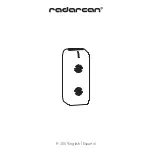
TC1796
Peripheral Units (Vol. 2 of 2)
Controller Area Network (MultiCAN) Controller
User’s Manual
22-22
V2.0, 2007-07
MultiCAN, V2.0
22.3.3
Port Input Control
It is possible to select the input lines for the RXDCANx inputs for the CAN nodes. The
selected input is connected to the CAN node and is also available to wake-up the
system. More details are defined in
at
22.3.4
Suspend Mode
The Suspend Mode can be triggered by the OCDS in order to freeze the state of the
module and to permit access to the registers (at least for read actions). The MultiCAN
module provides two types of Suspend Modes:
•
All actions are immediately stopped (Hard Suspend Mode):
The module clocks
f
CLC
and
f
CAN
are switched off as soon as the suspend request
becomes active. Read and write operations to the module are no longer possible.
This means that the CAN registers cannot be accessed anymore. In this mode, there
is a very high probability that the communication with other CAN devices is made
impossible, and that the CAN bus is blocked (e.g. if the suspended CAN module just
sends a dominant level). A reset operation must be executed to leave Hard Suspend
Mode.
•
The current action is finished (Soft Suspend Mode):
The module clock
f
CLC
keeps running. Module functions are stopped automatically
after internal actions have been finished (for example, after a CAN frame has been
sent out). The end of the internal actions is indicated to the fractional divider by a
suspend mode acknowledged signal. Due to this behavior, the communication
network is not blocked. Furthermore, all registers are accessible for read and write
actions. As a result, the debugger can stop the module actions and modify registers.
These modifications are taken into account after the Suspend Mode is left.
The Hard Suspend Mode can be enabled/disabled only for the complete MultiCAN
module. The Soft Suspend Mode can be individually enabled for each CAN node.
The fractional divider disables module clock
f
CAN
only if all CAN nodes signal that they
can be suspended. A CAN node that is not active can always be suspended.
The user has to be aware that the Soft Suspend Mode can corrupt the TTCAN timing
values, because the counter clock can be disabled. In order to guarantee correct TTCAN
behavior, a TTCAN node should not enter any Suspend Mode if the consistency of the
timing data must be ensured.
















































